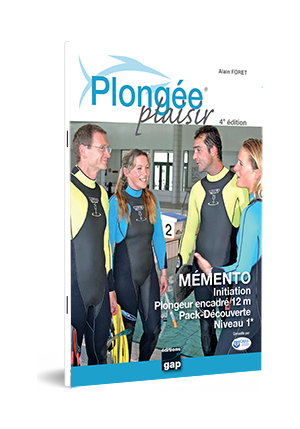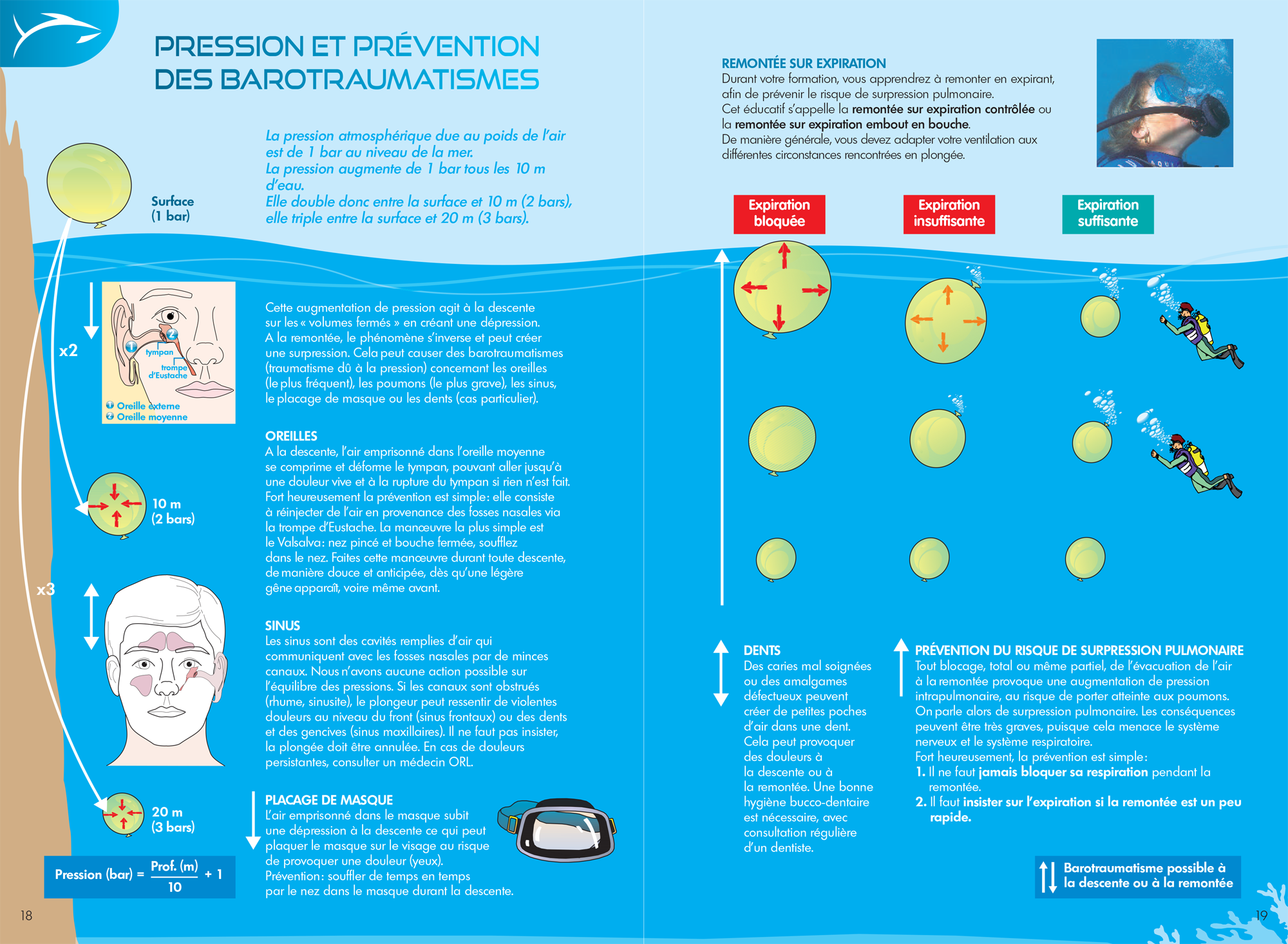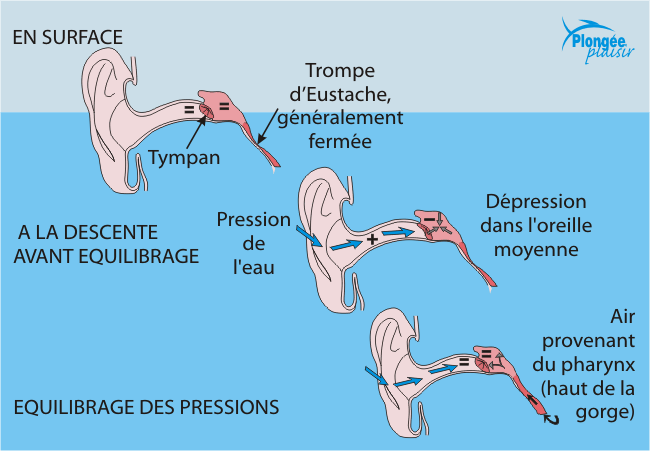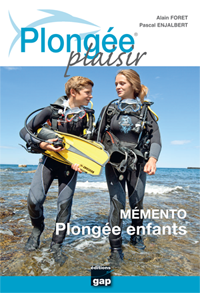
- Publisher: 32 p.
- Editor: GAP editions
- Editing: 3rd edition, 2019
- Available in: Paper, eBook
- ISBN: 9782 74170 6281
N ° 1 FOR DIVING TRAINING BOOKS
4th edition – July 2022![]()
Presentation
A clear, concise and complete guide in 32 pages to learn diving without making a mess, accessible to all.
Complies with the Sport Code and the program of the French Diving School (FFESSM, FSGT, ANMP, SNMP, UCPA) as well as the courses of the World Confederation of Underwater Activities (CMAS) and its member federations (French language: FLASSA-Luxembourg, FSSS-Suisse, CMAS.CH, LIFRAS-Belgium, CMAS Quebec,…).
Discover diving
Underwater diving requires training in order to be practiced safely. The "baptism of diving" is a "discovery dive" which allows you to have an overview of the activity, before validating your choice and engaging in training.
Once you have made your decision, you will need:
- define the type of training selected (year-round near you or blocked internship during your vacation);
- choose a diving school (associative club or commercial structure);
- provide administrative information (medical certificate, insurance, membership questionnaire, subscription, etc.).
Prerogatives
To start diving, the diving clubs or centers offer you, depending on your wishes and the time available, various certificates or qualifications with the following prerogatives associated:
- PE-12: dive supervised by a dive guide between 0 and 12 m;
- LEVEL 1 or PE20: dive supervised by a dive guide between 0 and 20 m.
At the end of your training, a patent card attesting to your level is issued to you.
Minor divers
In scuba diving, there are specific certificates for children, generally accessible from the age of 8. From the age of 12 and under certain conditions, children can access the adult course and pass level 1 as a diver. A minor diver must provide written parental authorization, signed by the legal representative of the family (father, mother, guardian).
To learn more about diving for children:Pleasure Diving Memento Children.
What is the price for a baptism or diving training?
- Baptism: Count from50 to 75 €depending on the place, the season (low, high) and the duration of the dive (standard or long baptism). Lower prices, around35 €can be seen in some structures. In certain exceptional areas in the tropical islands, the price can reach100 to 120 €. Introductions to diving can take place in a swimming pool or in a natural environment, in an associative club (year-round member) or in a commercial structure.
- PE-12 qualification(3 dives in general, theory included): from150 to 200 €depending on the place and the season.
- Level 1(PE-20, 5 to 6 dives in general, theory included): from300 to 500 €depending on the place and the season.
Where can I find a structure to learn to dive?
In France, more than 2,000 structures teach diving throughout the country. You can find them in the dive directory (www.annuairedelaplongee.com) or directly on the website of educational organizations:
Swimming pool, pit or natural environment?
Depending on your place of residence, your constraints and your desires, your training can take place in a swimming pool, in a diving pit or in a natural environment (sea, lakes, rivers, quarries). It can be spread over an entire season or be carried out as an intensive course over several days. Find out more from the reception structures.
Highlights of Pleasure Diving 1 memento
An effective synthesis, without concession on the knowledge to be acquired
In 32 pages,with double pages that can be read independently, many diagrams and photos, knowledge tests, it is a summary that allows a quick and fun reading. However, the content is rich, without concessions on the minimum level of knowledge to be acquired.

customizable
The possibility of personalizing the Memento by mentioning both the contact details of the diver and those of the club or the diving center to which they belong makes it possible to offer students quality support, which is beneficial for the host structure and for the supervision ( initiators, monitors).
Little price
At a retail price of €5.90, the Memento Plongée Plaisir is accessible to everyone, including clubs and diving centers wishing to include it in their training.
In the Pleasure Diving line of books
From a pedagogical point of view, the Memento is in line with the Plongée Plaisir books, N°1 of diving teaching books in France for 17 years.
CompletedmentalPleasure Diving 1
The Memento is complementary to the bookDiving for Pleasure 1where the reader will find more detailed explanations and additional content: autonomy from 0 to 12 m, underwater world, nitrox.
EXTRACTS
Example on the mask
Allows you to see correctly under water. To check that a mask fits you, put it on your face without using the retaining strap, inhale through your nose and then hold your breath. The mask should stand on its own. There are masks with 1 window, 2 windows or more. The 2-pane masks allow you to put on corrective lenses.
To prevent fogging while diving, use anti-fog liquid or put saliva on the inside of the glass and rub. In either case, rinse just before getting in the water.
Last advice: to avoid water ingress, do not tighten the strap too much and check that there is no hair (or part of the hood) caught under the skirt of the mask.
Example on the ears
The atmospheric pressure due to the weight of the air is 1 bar at sea level. The pressure increases by 1 bar for every 10 m of water. It therefore doubles between the surface and 10 m (2 bars), it triples between the surface and 20 m (3 bars).
This increase in pressure acts on the descent on the "closed volumes" by creating a depression.
On the ascent, the phenomenon is reversed and can create an overpressure. This can cause barotrauma (pressure trauma) involving the ears (most common), lungs (most severe), sinuses, mask veneer, or teeth (special case).
EARS
On the descent, the air trapped in the middle ear compresses and deforms the eardrum, which can lead to severe pain and rupture of the eardrum if nothing is done.
Fortunately prevention is simple: it consists of reinjecting air from the nasal cavities via the Eustachian tube. The simplest maneuver is the Valsalva: pinched nose and closed mouth, blow into the nose. Do this maneuver during any descent, gently and early, as soon as a slight discomfort appears, or even before.

SUMMARY
How to start diving?
equipment
Rig a spacesuitView excerpt page 6
The launch
Getting around: palmingView excerpt page 13
Immerse yourselfView excerpt page 14
Notions of apnea
Pressure and barotrauma preventionView excerpt page 18
Technical gestures and essential notions
Diving signs and risk prevention
Ascent: the desaturation phaseView excerpt page 24
Get out of the water, get unequipped
Diver test level 1
The Pleasure Diving seriesView excerpt page 32
Printed on certified paper made from paper pulp from sustainably managed forests. The ink used is based on vegetable oil, the printing press adopts a progressive environmental approach validated by Imprim'vert certification.
A question, a suggestion, talk to the author, Alain FORET: Click here.


